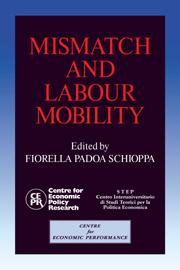Book contents
- Frontmatter
- Contents
- List of figures
- List of tables
- Preface
- Acknowledgements
- List of conference participants
- 1 A cross-country comparison of sectoral mismatch in the 1980s
- 2 Mismatch: a framework for thought
- Discussion
- 3 Match and mismatch on the German labour market
- Discussion
- 4 Mismatch in Japan
- Discussion
- 5 Mismatch and internal migration in Spain, 1962–86
- Discussion
- 6 Regional inequalities, migration and mismatch in Italy, 1960–86
- Discussion
- 7 Skill shortages and structural unemployment in Britain: a (mis)matching approach
- Discussion
- 8 Labour market tightness and the mismatch between demand and supply of less-educated young men in the United States in the 1980s
- Discussion
- 9 Skill mismatch, training systems and equilibrium unemployment: a comparative institutional analysis
- Discussion
- 10 Unemployment, vacancies and labour market programmes: Swedish evidence
- Discussion
- 11 Mismatch and labour mobility: some final remarks
- Index
9 - Skill mismatch, training systems and equilibrium unemployment: a comparative institutional analysis
Published online by Cambridge University Press: 05 October 2010
- Frontmatter
- Contents
- List of figures
- List of tables
- Preface
- Acknowledgements
- List of conference participants
- 1 A cross-country comparison of sectoral mismatch in the 1980s
- 2 Mismatch: a framework for thought
- Discussion
- 3 Match and mismatch on the German labour market
- Discussion
- 4 Mismatch in Japan
- Discussion
- 5 Mismatch and internal migration in Spain, 1962–86
- Discussion
- 6 Regional inequalities, migration and mismatch in Italy, 1960–86
- Discussion
- 7 Skill shortages and structural unemployment in Britain: a (mis)matching approach
- Discussion
- 8 Labour market tightness and the mismatch between demand and supply of less-educated young men in the United States in the 1980s
- Discussion
- 9 Skill mismatch, training systems and equilibrium unemployment: a comparative institutional analysis
- Discussion
- 10 Unemployment, vacancies and labour market programmes: Swedish evidence
- Discussion
- 11 Mismatch and labour mobility: some final remarks
- Index
Summary
Introduction
Considerable work has now been done on the incorporation of comparative industrial relations institutions into the explanation of wage bargain outcomes and hence into macroeconomic models, as in Calmfors and Driffill (1988) and Jackman, Layard, Nickell and Wadhwani (1991) (hereafter JLNW). There is virtually no comparable work on the comparative role of education and training (ET) systems. This study is a preliminary attempt to see how the relations between ET systems, mismatch and equilibrium unemployment might fit into a simple version of the open economy model in Chapter 8 of JLNW.
The study draws first on the now substantial literature on comparative national ET systems (Sorge and Warner, 1980; Dore, 1987; Finegold and Soskice, 1988; Maurice, Sellier and Silvestre, 1986). To replicate as far as possible the country study chapters in this volume, section 3 looks at Germany, Japan, Sweden, the United Kingdom and the United States. The focus, as in much of the ET literature, is on the initial/further/and re/training of workers up to the technical level, thus leaving higher education aside. The consensus view in the literature is that Germany, Japan and Sweden have effective ET systems, while the United Kingdom and the United States do not. The literature on ET systems does not define ‘effectiveness’ clearly, but two criteria are implicitly used: first, the reduction of skills mismatch; and second, reflecting the preoccupation of policymakers with international competitiveness, the increased provision of skills needed for export success, and more generally a labour force which is well educated and trained.
- Type
- Chapter
- Information
- Mismatch and Labour Mobility , pp. 386 - 400Publisher: Cambridge University PressPrint publication year: 1991
- 2
- Cited by



